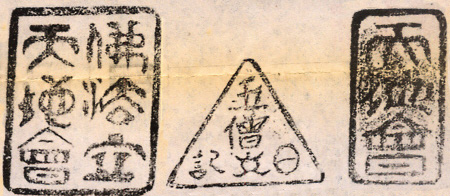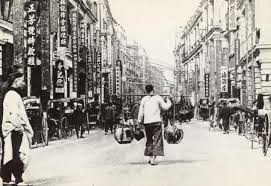Many Kung Fu styles trace their origins to an alleged Shàolín 少林 temple in the southern province of Fújiàn 福建 (Fukien), which would be attacked by the troops of the Qīng 清 dynasty, and from which only five monks, known as the Five Elders or Five Ancestors of Shàolín (少林五祖 Shàolín wǔ zǔ), would escape.
Although this story is widespread among martial arts circles in southern China, today we know that it is, in all likelihood, false. Although several places have been mentioned as possible enclave for this Southern Shàolín Temple, it is not proven that these enclaves had any relation to the Shàolín Temple in Hénán 河南, or to any martial arts tradition. (To learn more: The Southern Shaolin Monastery, Between Myth and Reality).

One of the (new) temples that aspire to be recognized as Southern Shàolín, in Fúqīng 福清.
On the contrary, if we look at the written texts, the first references to the existence of this temple, its burning, and the legend of the five elders comes from two main sources: the founding myth of the secret society of Heaven and Earth, or Tiān Dì Huì 天地會, and the fictional novels of the nineteenth and twentieth centuries published in Guǎngdōng 廣東 and Hong Kong 香港 and represented by the 1893 anonymous novel titled Shèng Zhāo Dǐng Shèng Wàn Nián Qīng 圣朝鼎盛万年青 ("The Flowering of the Holy Dynasty", a title that has been translated into English simply as Everlasting, with which we will refer to it from now on, for convenience).
The legend of the burning of Shàolín:
The legend that circulates between martial artists today and of which most Southern styles echo to explain their origins may vary slightly from one version to another, but in general it is as follows:
In the early 18th century, the Qīng government requested help from the monks of the Shàolín monastery to deal with the attacks of a Mongolian tribe called Xīlǔ 西魯. The monks' performance in the battle, which ended in victory, impressed the emperor so much that he came to fear the possibility of having them as enemies should they rebel, so he secretly decided to take them all down.
Thus, the emperor sent troops to destroy the temple, counting on the collaboration of one of the monks from within who, betraying the rest of the order, would facilitate the attack of the imperial troops.
Almost all of the monks were killed during the attack, except for eighteen of them, who managed to escape. Discovering this fact, imperial troops would pursue them for 70 days managing to wipe out thirteen. Only five, then, would survive. (According to another version, these thirteen monks would die after escaping because of the wounds received during the battle.)
A variety of dates between 1647 and 1732 have been given in the stories for the destruction of this temple. Thus, the name of the emperor who would order destruction varies: Yōngzhèng 雍正, Shùnzhì 順治 or Kāngxī 康熙. Defenders of this legend also claim that the temple would have been the target of repeated attacks until its ultimate burning.
On the other hand, most versions of this story refer to the temple of Southern Shàolín, but there is even a version that places the episode in the temple at Hénán. While there is no evidence of the existence of a temple in the South, supposedly built under patronage of the Míng 明 dynasty, we know that the north temple version is definitely false, despite having suffered other attacks both before and after.

The Pagoda Forest, in the Shàolín monastery in Hénán 河南.
Returning to the legend, the list of the five survivors varies. One version gives the names of Choy Dak Zung 蔡德忠, Fong Dai Hung 方大洪, Ma Chiu Hing 馬超興, Wu Dak Dai 胡德帝, and Lei Sik Hoi 李式開 (we have transcribed these names into Cantonese, as it is in Canton that this story mainly circulated).
Other lists name Miu Hin 苗顯 (who would not be a monk but a lay disciple), Fung Dou Dak 馮道德 or Zi Sin 至善, even other names, in place of some of those already mentioned; later versions include Ng Mui 五梅, always making a total of five. The traitor's name also varies: sometimes Ma Ji Fuk 馬儀幅, sometimes Bak Mei 白眉.
Whatever their names, these Five Elders would swear to propagate the Martial Arts of Shàolín and fight the dynasty, under the motto fǎn qīng fù míng 反清復明 ("overthrow the Qīng and restore the Míng").
Southern Kung Fu styles claim offspring from one or the other of these survivors, who would teach either the founders of Hung Ga Kyun 洪家拳 or Choy Li Fut 蔡李佛 or their masters and, in the case of Wing Chun 詠春, the creation of the style by Ng Mui herself.
The Society of Heaven and Earth
The Society of Heaven and Earth or Tiāndìhuì 天地會 was a secret organization founded in 1761 by a monk named Tíxǐ 提喜 in Fújian province, and is also known as Hóng Mén 洪門 (or Hung Mun, in Cantonese).
Although it has was believed that from the beginning its purpose was the overthrow of the Manchu-origin Qīng dynasty, it seems that it was originally intended solely for economic aid and mutual protection among its members, who would belong to marginalized groups. However, as such societies were illegal during the time of Manchu domination, and consequently persecuted, inevitably the Tiāndìhuì would eventually approach the orbit of the anti-Qīng resistance groups, making this resistance, eventually, its main activity.

Seals of the Society of Heaven and Earth, Tiāndìhuì 天地會.
It was then, in the early 19th century, that their founding myth was created: the five surviving monks of the burning of Souther Shàolín, in alliance with other individuals loyal to the Míng dynasty, would found legitimidad to fight the Manchu dynasty.
It is believed that the creation of this fictional story would have given legitimacy to the secret society in its activities, which would now have taken on a political and revolutionary character.
The martial arts fiction novels
In 1893, the novel Shèng Zhāo Dǐng Shèng Wàn Nián Qīng 圣朝鼎盛万年青 ("The Flowering of the Holy Dynasty") was published in Guǎngdōng and Hong Kong, to which we will refer by its abbreviated title in English, Everlasting. This novel told the story of the burning of Shàolín, which we have already told, and the escape of the five surviving monks.
Until that time, and with the exception of the founding myth of the Tiāndìhuì society, it does not seem to have existed in the region any source of popular folklore related to Shàolín, in which the martial artists of the time would inspire. However, after the publication of Everlasting, there was a boom in novels inspired by that one, an inspiration that reached the literal copy and plagiarism of entire passages. Each novel adapted the story to the author's liking, introduced new changes and characters; and as a common denominator, heroes characterized by their resistance to the Manchu government and their struggle in the assistance of the oppressed ones.

Illustration of a novel of the genre Guǎng pài wǔ xiá xiǎo shuō 廣派武俠小說
("Guǎngdōng School of martial arts fiction").
All this narrative would become a genre of its own, which has been called Guǎng pài wǔ xiá xiǎo shuō 廣派武俠小說 ("Guǎngdōng School martial arts fiction") and would spread in the cultural and linguistic area of Guǎngdōng, including Hong Kong. In this diffusion, newspapers played an important role. Publications that were banned in Guǎngdōng saw the light in Hong Kong, which was a British colony, and were sold across the border at recharged prices.
This genre of martial fiction was the source from which, later, most Southern styles would adopt the stories of their origins.

Hong Kong Street in the early 20th century, when some Southern styles began to adopt the stories
of martial arts fiction as their own.
On the other hand, it seems that the anti-Qīng sentiment and the revolutionary spirit, so typical of the current foundational stories of southern styles, was alien to the majority of the population at the time. This feeling would only arise in the last years of the dynasty, starting with the revolution of 1911. It is possibly that, from then on, Southern Kung Fu styles began to be associated with the revolutionary groups and the stories about the Five Elders of Shàolín.
According to Christofer Hamm, the appropriation of these fictions by martial arts circles would not respond to an unthinking impulse but to a conscious choice of one tradition over another. This election is in turn a reflection of the social changes that occurred in those years in southern China.
Sources:
- Hamm, John Christopher. Paper Swordsmen: Jin Yong And The Modern Chinese Martial Arts Novel, 2005 University of Hawai’i Press.
- Kung Fu Tea: Did Ip Man Invent the Story of Yim Wing Chun?
- Order of Shàolín Ch’an. The Shàolín Grandmaster’s Text. History, Philosophy, and Gung Fu of Shàolín Ch’an, 2006 Beaverton, Oregon.
- Sihing Nico's Talk: A brief history of secret society Tiandihui
Related articles:
